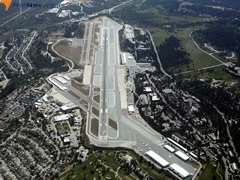 Controversy over service road key to judge’s ruling – For the second time, a Monterey judge has halted the Monterey Regional Airport’s $46 million runway extension project, largely because of a controversial proposed service road.
Controversy over service road key to judge’s ruling – For the second time, a Monterey judge has halted the Monterey Regional Airport’s $46 million runway extension project, largely because of a controversial proposed service road.
Judge Lydia Villarreal said the district had again failed to consider alternatives to the new roadway, the purpose of which was not initially disclosed. She indicated the district planned the road to obtain 144,000 cubic yards of dirt, enough to fill 11,866 dump trucks, to build an area to contain a larger-than-required crash pad to the south of the runway.
Villarreal told the district to return to the drawing board and return with a complete environmental review. In the meantime, she said, the airport could proceed with the federally-required safety project without the road.
Tom Greer, general manager of the airport, blasted the ruling, saying it would cause the district to lose a federal grant for the project and cost the region hundreds of jobs. He said the airport’s board of directors is “exasperated” because similar safety projects are being built or have been completed at other airports across the country. The roadway, he said, would provide access to emergency vehicles.
“Our legal team has worked hard to get the court to understand that a perimeter service road is critical for all commercial service airports, especially in light of the crash that occurred last week in San Francisco where an airplane landed short of the runway.”
The ruling was another victory for the Highway 68 Coalition, which challenged the original environmental impact review in 2012. The coalition’s original lawsuit complained that the two-lane road that would run from Highway 68 up the hill west of Tarpy’s Restaurant was a thinly disguised effort to provide access to a 150-acre parcel planned for an office park.
It also objected to a retaining wall to be built along Highway 68 to accommodate a crushable concrete pad at the airport’s southeast corner that would prevent aircraft from overshooting to the hillsides below.
Villarreal agreed with the coalition in May 2012 that the EIR failed to consider the growth-inducing effect of the road, as well as the impact on greenhouse gases of removing more than 300 oak trees from the hill.
Alexander Henson, one of two attorneys for the coalition, said Tuesday his clients now agree the road was not part of a “secret plan” to access the 150 acres. The problem, he said, was the district’s failure to disclose the true purpose: access to fill dirt.
“They did not want to admit they were building a mountain for $20 million,” he said. “The problem is, environmentally speaking, there’s no reason to wipe out eight acres of oak forest on that property just to provide fill when it will serve no purpose.”
The area in question, he said, is 500 feet off to the side of the runway and is not part of the federal mandate.
“No airplane is going to get, or ever has gotten that far off,” the runway, he said.
Henson said he warned the district after it circulated the supplemental EIR that it needed to consider alternatives to the road and it refused.
The $46 million project, mandated by the Federal Aviation Administration, would provide crushable pads at either end of the runway to stop any airplane that over- or undershoots the runway.
Greer said the board of directors would consider its options as quickly as possible. He cautioned, however, that the courts ruling will likely cost the district its initial federal grant, about $27 million, and make it impossible to meet the Dec. 31, 2015, deadline for completion.
“The judge, for reasons known only to her, decided that the efforts of the district to address each and every concern she had raised previously, had not been adequately addressed,” he said. “Her decision mirrored, remarkably, the exact arguments of opposing counsel, to the extent they could have written them.”
